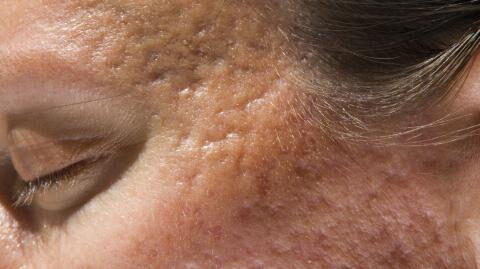There are two types of people in this world, those that wear their scars proudly and those that do everything in their power to get rid of them. But, no matter which team you’re on, nobody is excited about scars on the face, especially when they come from acne.
Discover our latest podcast
There are two types of acne scarring, atrophic and hypertrophic.Atrophic scars are pitted and often resemble holes in the face, while hypertrophic scars are raised and wide. Both types of scarring can be hard to treat as they are ultimately related to collagen production in the skin.
What are hypertrophic scars?
Hypertrophic scars are wide, raised scars that can either be red, pink or pale. These scars are expected during the skin healing process and occur due to an abnormal response to skin injury.
Hypertrophic scars are caused by skin cells called myofibroblasts that produce too much collagen during the healing process. This response can occur due to a person’s skin type or healing tendencies. However, hypertrophic scarring is more common in wounds that are inflamed, infected or are in areas of movement such as the joints.
These scars aren’t dangerous or life-threatening; they can sometimes be itchy or painful but are mostly considered a cosmetic issue.
Hypertrophic vs keloid scars
Hypertrophic scars often get confused for similar keloid scars. Both are raised, but keloid scars are considered to be more intense than hypertrophic scars.
Keloid scars can be identified as:
- Being raised more than 4mm
- Being able to grow over time and beyond the boundaries of the wound
- Pink or purple
- Growing mainly on the upper body
On the other hand, hypertrophic scars identity as:
- Being raised by lass than 4mm
- Being able to occur anywhere on the body
- Being pink or red
How are hypertrophic scars treated?
Treatments for hypertrophic scarsrange from simple home treatments to dermatologist procedures. The method of treatment that’s best for your hypertrophic scar depends on its severity and response to at-home treatments.
Pressure and massage
Sometimes, hypertrophic scars respond well to at-home treatments involving massage and pressure. Either massage the scar regularly or use tape and pressure bandages on the area. This will help to loosen the scar tissue and reduce its appearance over time.
Silicone sheets
Silicone elastomer sheets are another non-invasive, at-home treatment for hypertrophic scars and can be applied as soon as the skin heals after injury. Many silicone treatments such as sheets, gels and sprays are available as over the counter products. To use silicone on your scar, apply a sheet to the scar for 12-24 hours per day for about three months. With a gel, apply it to the scar multiple times a day over the same period.
Laser therapy
Laser therapy is an effective dermatologist treatment for newly formed hypertrophic scars. Lasers will burn and flatten the raised scar tissue and even target the pigmentation of the scar.
Cryotherapy
Small studies have seen cryotherapy to be an effective, safe and well-tolerated treatment for hypertrophic scars. In a cryotherapy treatment, a doctor or derm will freeze your scar to flatten the raised tissue with liquid nitrogen.
Surgery
If your hypertrophic scar doesn’t fade away after a year, surgery may then become an option. During surgery, the scar tissue is removed or cut out, and the new wound is then closed with stitches. Hypertrophic scar surgery aims to remove the scar tissue and inflamed or once infected tissue that caused the scar to form in the first place. Then, the new wound can reheal properly.
Steroid injection
Steroid injections have long been a treatment for hypertrophic scars and cause the scarring process in the wound to come to a halt. As a result, the scar will begin to shrink. Steroid injections are harder to administer uniformly to more prominent hypertrophic scars but are effective when used in conjunction with cryotherapy.
Dermabrasion
Dermabrasion, while not suitable for keloid scars, can be used for large hypertrophic scars. During this process, anaesthetic is administered, and the clinician will use a tool to remove the top surface of the scar. This method doesn’t remove hypertrophic scars altogether, but it does change their colour and texture to better blend in with the surrounding skin.















